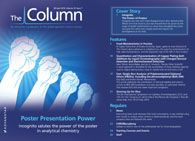Analyzing Water Content in Solid Pharmaceuticals
A new approach for the analysis of water in solid pharmaceutical products using headspace gas chromatography (HSGC) with an ionic liquid (IL)-based open tubular capillary GC column has been proposed by scientists at the University of Texas at Arlington (Texas, USA). Published in the Journal of Pharmaceutical and Biomedical Analysis, the study states that the sensitivity of the method is 100 times that of the commonly used volumetric Karl Fischer Titration (KFT) (1).
A new approach for the analysis of water in solid pharmaceutical products using headspace gas chromatography (HSGC) with an ionic liquid (IL)-based open tubular capillary GC column has been proposed by scientists at the University of Texas at Arlington (Texas, USA). Published in the Journal of Pharmaceutical and Biomedical Analysis, the study states that the sensitivity of the method is 100 times that of the commonly used volumetric Karl Fischer Titration (KFT) (1).
Determining the levels of water within commercial drugs is essential as it can be associated with decreased shelf life, drug instability, and the encouragement of microbial growth. It can also vary throughout the product supply chain, and so continual monitoring is essential. Lead author Daniel W. Armstrong of the University of Texas (USA) told LCGC: “Analyses for water are among the most ubiquitous measurements done in the world. They are often mandated by regulatory agencies for many consumer products including drugs.”
Commonly used methods for assaying water in pharmaceuticals are KFT and “loss on drying”. “Loss on drying” is not particularly accurate as it depends on the evaporation of water from a sample, and many drugs are vulnerable to heat treatment. KFT is also plagued by a number of issues as well, such as high solvent consumption and long analysis time. Furthermore, when handling solid samples, sample preparation steps can further complicate analysis.
The team had already developed a capillary GC method to measure water in a range of solvents, using newly developed IL stationary phases, according to Armstrong, and the big question for them was: “Could we also develop an ionic liquid-based GC method to measure water in solids?”
Armstrong said: “Obviously you can’t directly inject a solid directly into a GC. If you dissolve it (the solid sample) in some solvent, you will get a huge solvent peak in your chromatogram and the nonvolatile solid material will collect and decompose in your injector. We decided to see if we could use a headspace approach in which we also used another IL as the solvent in the headspace vial (because the IL, which is not volatile, would not be present in the headspace and therefore not be in the chromatogram either).”
The team performed KFT, limit of detection (LOD), and HSGC for the analysis of water content in 23 standard compounds including ibruprofen and warfarin. LOD was found to be ineffective for nearly half of the compounds tested as the samples degraded during the experiment or were subject to side reactions. The sensitivity of the HSGC method was shown to be higher than volumetric KFT by up to 100 times, allowing small sample sizes to be analyzed.
Reference
1. D.W. Armstrong et al., Journal of Pharmaceutical and Biomedical Analysis94, 111–117 (2014).
This article is from The Column. The full issue can be found here.

Analysis of PFAS in Milk by LC-MS/MS
May 15th 2025Dairy milk is one commodity that can be impacted by environmental contaminants, such as PFAS, so it is important to implement extensive, robust, and accurate testing. In this work, a sensitive and reliable method was developed for the analysis of PFAS in milk by LC-MS/MS at levels as low as 0.01 µg/kg.

.png&w=3840&q=75)

.png&w=3840&q=75)



.png&w=3840&q=75)



.png&w=3840&q=75)










